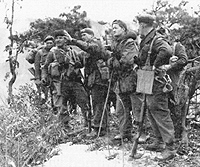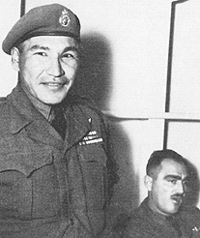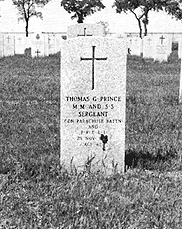Prince Returns to Action
Note
There have been recent changes to the Korean alphabet. For example, Pusan now reads Busan and Kapyong reads Gapyong. In order to maintain historical relevance, the older versions of the names are used in this article.

Sgt. Prince (2nd from left) and other officers of the PPCLI's 2nd Battalion are briefed by their commanding officer before setting out on patrols in Korea in March 1951. As second in command of a rifle platoon, Prince participated in and led several night patrols and raiding parties. (W. H. Olson / Department of National Defence / Library and Archives Canada / PA-114890)
Three of the 11 medals Tommy Prince earned during his military career—the Korea Medal, the United Nations Service Medal and the Canadian Volunteer Service Medal for Korea—were for service during the U.N. operations in Korea. In August 1950, one week after the government announced its decision to form the Special Force, 34-year-old Tom Prince volunteered. He joined the 2nd Battalion, Princess Patricia's Canadian Light Infantry (PPCLI), the first Canadian Army unit to arrive in the region.
Prince was in action quickly. In February 1951, the Patricias joined the 27th Commonwealth Brigade on the battlefield. Soon after arriving in the war zone, the sergeant, who was second in command of a rifle platoon, led an evening "snatch patrol" of eight men into an enemy camp. The raid was a success; the group returned before dawn with two captured machine-guns. More raids followed. However, according to the authors of a biography of Prince, he was eventually assigned fewer patrols, because his commanding officer thought Prince took too many chances that might risk the lives of the soldiers under his command.87
Prince was with 2 PPCLI when, together with the 3rd Royal Australian Regiment, it was awarded the United States Presidential Unit Citation for distinguished service in the Kapyong valley April 24 and 25, 1951, during one of the toughest actions of the war.88 The Patricias were to hold a defensive position at Hill 677 so that a South Korean division could withdraw during an attack by Chinese and North Korean forces. Although at one point the battalion was surrounded and resupply of ammunition and emergency rations could only be accomplished by air, the Patricias held their ground. The enemy withdrew. Ten PPCLI men were killed and 23 were wounded during the two-day battle. The award was a first for a Canadian unit.

Prince en route to Korea—for the second time. (J.J. Schau / Department of National Defence /Library and Archives Canada / PA-128264)
Prince's time at the front was intense but brief. His knees were subject to painful swelling and premature arthritis. It was a struggle for him to endure the constant, steep climbing demanded by the Korean landscape. After a medical examination in May 1951, he was hospitalized and then assigned administrative duties. In August he returned to Canada.
Prince remained on active service as an administrative sergeant at Camp Borden in Ontario. Here his knees responded to the added rest and thus, in March 1952, he volunteered for a second tour of duty in the Far East. He sailed for Korea that October with the 3rd Battalion PPCLI.
In November 1952, the training of the 3rd PPCLI in Korea was interrupted by fighting on "the Hook," a key position west of the Sami-chon River that overlooked much of the rear areas of the U.N. forces. When a Chinese battalion gained a foothold on the forward positions of another UN unit on November 18, the 3rd PPCLI was ordered to help defend the sector. By dawn of the 19th, the UN unit, with assistance from the Patricias, had recaptured the post. Five Patricias were killed on the Hook and nine were wounded, one of whom was Sergeant Prince.
Prince recovered from the injury, but began to have continual difficulties with his arthritic knees. Between January and April he spent several weeks in hospital. In July 1953, the Korea Armistice was signed, and, the following November, Prince returned to Canada. He remained in the army, stationed at a personnel depot in Winnipeg, until September 1954.

Tommy Prince's Grave.
Tommy Prince died at Winnipeg's Deer Lodge Hospital in November 1977, at the age of 62. At his funeral, a delegation of the Princess Patricias served as pallbearers and draped a Canadian flag over his coffin for the memorial service. It was an impressive tribute:
As the trumpeter finished, five young men from the Brokenhead Indian Reserve began to chant the melancholy "Death of a Warrior" song, as drummers beat a sad lament . . . . The crowd of over 500 included people from all walks of life: active soldiers, Veterans, Manitoba's Lieutenant Governor Jobin, consuls representing France, Italy and the United States, farmers, fishermen, trappers, businessmen and many others.89
- Date modified: